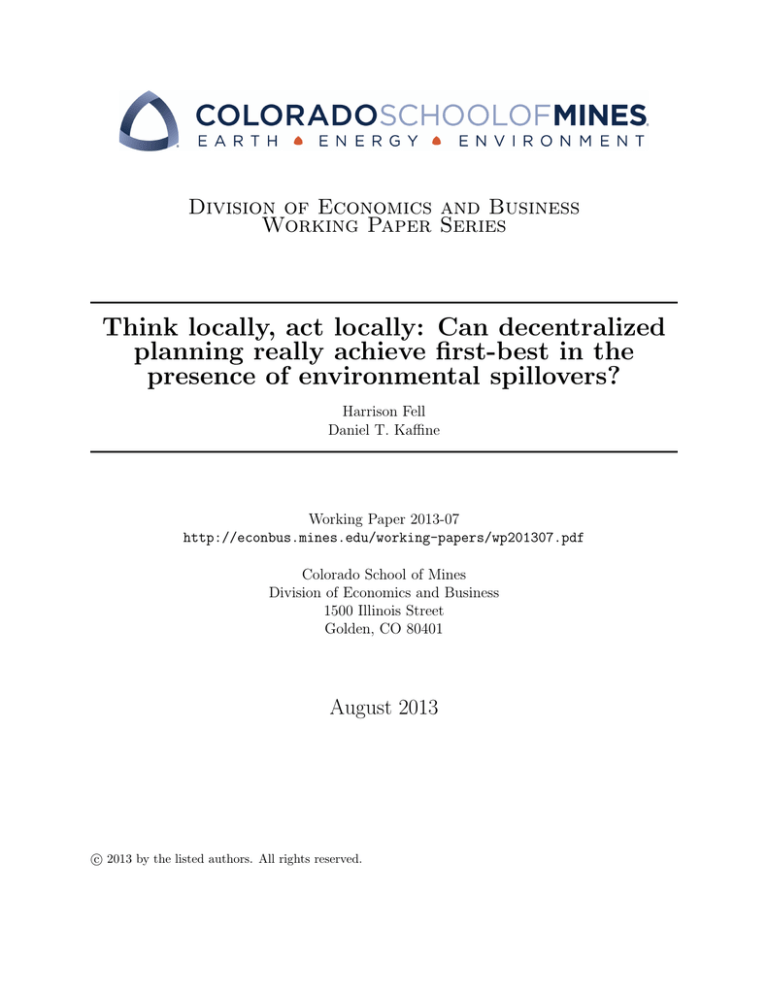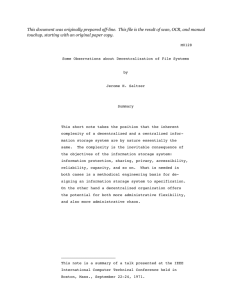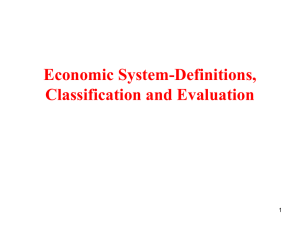
Division of Economics and Business
Working Paper Series
Think locally, act locally: Can decentralized
planning really achieve first-best in the
presence of environmental spillovers?
Harrison Fell
Daniel T. Kaffine
Working Paper 2013-07
http://econbus.mines.edu/working-papers/wp201307.pdf
Colorado School of Mines
Division of Economics and Business
1500 Illinois Street
Golden, CO 80401
August 2013
c 2013 by the listed authors. All rights reserved.
Colorado School of Mines
Division of Economics and Business
Working Paper No. 2013-07
August 2013
Title:
Think locally, act locally: Can decentralized planning really achieve first-best in the presence
of environmental spillovers?
Author(s):
Harrison Fell
Division of Economics and Business
Colorado School of Mines
Golden, CO 80401-1887
hfell@mines.edu
Daniel T. Kaffine
Division of Economics and Business
Colorado School of Mines
Golden, CO 80401-1887
+1 303 384 2430
dkaffine@mines.edu
ABSTRACT
Strikingly, Ogawa and Wildasin (2009) find that in a model with heterogenous jurisdictions, interjurisdictional capital flows, and interjurisdictional environmental damage spillovers, decentralized planning outcomes
are equivalent to that under a single centralized planner. Taken to its extreme this result renders international agreements such as the Kyoto Protocol irrelevant. We first show the critical importance of two key
assumptions (no retirement of capital, fixed environmental damages per unit of capital) in obtaining this
result. Second, we consider a more general model allowing for capital retirement and abatement activities
and show that generally the outcome of a decentralized market differs from the solution of a centralized
planner’s social welfare-maximizing problem.
1
Introduction
Delegates from numerous countries continue to hold summits in an effort to craft international agreements that address global environmental challenges, such as climate change.
Based on the recent work of Ogawa and Wildasin (2009), hereafter OW, these efforts may
be unnecessary. OW construct a multi-jurisdictional model showing that when production
creates environmental damages, which may have interjurisdictional spillover effects (i.e., interjurisdictional externalities), the decentralized planning efforts lead to the same capital
allocation as that chosen by a single centralized planner.1 Their result holds even when the
jurisdictions have heterogeneous preferences over the environmental damages and differences
in production capabilities. This is an amazingly powerful result as it implies that internationally uncoordinated efforts to respond to global environmental issues will lead to efficient
outcomes, negating the need for international environmental agreements such as the Kyoto
protocol. The result is equally stunning because it runs contrary to much of the established
public and environmental economics literature on production efficiency in the face of externalities. Taken to its logical conclusion, their result implies that there may be a fundamental
error in how economists, from Pigou (1920) to Samuelson (1954) to the present, think about
externalities and public goods.
However, in this short analysis, we show that this result is purely an artifact of a highly
stylized and unrealistic modeling assumption. More specifically, OW assume that, regardless
of whether we consider the centralized planner problem or the decentralized problem, global
capital is exogenously given and fixed. Combining this assumption with their formulation of
Their work builds off of Oates and Schwab (1988) who show efficiency of decentralized
planning in the absence of interjurisdictional spillovers.
1
2
how environmental damages are generated leads to a fixed sum of environmental damages
across jurisdictions. In other words, the centralized planner cannot reduce global environmental damages by construction. We go on to more generally characterize the conditions
under which a wedge exists between the outcomes under the centralized planner model and
that of the decentralized model. Allowing for capital-retirement or abatement activities leads
to inefficient decentralized planning in all but the most extreme cases. Recent work by Eichner and Runkel (2012) show a special case of our more general point, whereby the central
result of OW breaks down in a two-period model with capital adjustment if the elasticity
of capital supply is positive.2 However in a more general static model setting, no dynamic
considerations are needed to reject the main result of OW.
2
Fixed Total Environmental Damages Assumption
Consider the set-up from OW for N jurisdictions indexed by i. Equation 1 of their paper
gives the following expression for the environmental damage in a given jurisdiction ei as:
ei = aki + β
X
akj
(1)
j6=i
where a is units of local environmental damage per unit of capital ki , and β represents
the degree of environmental damage spillovers from other jurisdictions (β ∈ [0, 1]). Note
In brief, cumulative damages are endogenized in Eichner and Runkel (2012) as the local
capital tax reduces the net rate of return to capital, which in turn affects the savings decisions
of households in a two-period model. Household savings affects cumulative capital and thus
cumulative environmental damages when the capital supply elasticity with respect to the net
return on capital is positive. We note that the result in Eichner and Runkel (2012), whereby
decentralized decisions are efficient “...for economies where the capital supply elasticity has
been found to be negligible,...”, is subject to the same criticism developed below in the
context of the original model in OW.
2
3
ei , a unit of environmental damage in i, is not the same as the “cost” of pollution felt by
those in i. Environmental damage enters the representative utility function, so the cost
of environmental damage is represented through the marginal disutility of environmental
damage (uei ). For example, in the global warming context ei may represent temperature
increase in i, and the harm associated with a marginal increase in temperature need not be
the same across jurisdictions (uie 6= uje ).
Capital is assumed to obey the following (equation 2):
X
k̄i =
X
ki
(2)
i
i
where k̄i is the endowment of capital in a jurisdiction. Thus, while capital is mobile, the
cumulative capital used has to equal the sum of the initial endowments (k̄ =
together equations 1 and 2 imply:
P
i
k̄i ). Taken
ei = aki + aβ(k̄ − ki ).
(3)
The previous three equations restate equations (1) - (3) in OW. To calculate the cumulative level of environmental damage, sum across all N jurisdictions:
N
X
i
ei =
N
X
i
(aki + aβ(k̄ − ki )) = ak̄ + aβ k̄N − aβ k̄ = ak̄(1 + β(N − 1)) = ē.
(4)
Though never explicitly stated in OW, their modeling assumptions imply the sum of the
environmental damages is equal to an exogenous constant (ē). At this point, a centralized
planner (or any other decision-maker) has as much control over cumulative environmental
damage units as he does over the tilt of the Earth’s axis or Planck’s constant.
Two important points follow. First, equation 4 implies a regulator can only shift environmental damages across jurisdictions, but not reduce aggregate damages. The issue becomes
4
even more alarming when one considers the case of global stock pollutants such as CO2
within the context of this model. As noted in OW this case corresponds to the parameterization of β = 1. With β = 1, environmental damages (e.g., temperature increases) in all
∀i, j. Combining this with the condition that
jurisdictions are equal such that ei = ej = ak̄
the sum of environmental damages across jurisdictions is constant implies the centralized
planner can do nothing to lower average temperature increases ( Nē ) nor can it lower the level
of environmental damage in any region. That is, the centralized planner is stuck with the
business-as-usual environmental damage case. Therefore for this special case it is perhaps not
surprising, and indeed follows from the first fundamental theorem of welfare economics, that
the social planner would allocate capital in a way consistent with a decentralized competitive
market.
Second, such a model setting appears detached from the debate on current global environmental issues. For example, when international summits on climate change are held,
delegates are not simply meeting to decide how temperature increases should be distributed
across countries, but rather they are primarily concerned with the appropriate level of average temperature increase ( Nē ). Thus, while OW motivate their model in part by appealing
to interjurisdictional spillovers such as CO2 emissions, their modeling assumptions are illequipped to deal with the central question actually facing policymakers.3
In the next section, we relax the assumption that all capital must be allocated, effectively
allowing for capital retirement. In the decentralized case, this corresponds to a situation
where local environmental policies are sufficiently stringent to drive the net rate of return on
Even with pollutants where location of the pollution matters (e.g., SO2 and NOX ), first
order policy discussions are primarily concerned about aggregate levels of abatement.
3
5
capital to zero. In the centralized case, this corresponds to a situation where a centralized
planner simply chooses to not allocate the full capital endowment.
3
Capital retirement
We now relax the basic model in OW to allow for capital retirement. While the original
model also includes a local public good, we abstract from this consideration as it is not
relevant for this paper.4
It should also be noted that one could augment OW to allow for
environmental damage reductions in any general way beyond just capital retirement and still
arrive at the same general conclusions made below. We, however, focus on the relaxation
of capital retirement because as noted above, the assumption of a fixed capital stock is of
fundamental importance in the OW model.
The general framework of OW remains the same. The composite private good xi is
produced with capital given by the increasing and strictly concave production function fi (ki ),
where fik > 0, and fikk < 0. A representative household in each jurisdiction consumes this
private good and is affected by environmental damage ei , with utility denoted by ui (xi , ei )
such that uix > 0 and uie < 0. We simply relax the capital constraint in equation 2 to be
P
i
k̄i ≥
3.1
P
i
ki to allow for capital retirement.
Decentralized problem
We first begin with the problem faced by decentralized policymakers. Equivalent to equation
4 in OW, private consumption in each jurisdiction is given by:
4
OW also note that local public goods do not play a crucial role in their analysis.
6
xi = fi (ki ) − fik ki + ρk̄i + Ti
(5)
where fik is the marginal productivity of capital, and ρ is the net rate of return to capital.
P
P
To allow for the fact that capital may not be fully allocated ( i k̄i ≥ i ki ), the net return
to capital satisfies ρ ≥ 0. The government in each jurisdiction can charge a tax on capital
ti such that Ti is a lump-sum subsidy (a tax to fund a local public good in OW) households
receive from any tax revenues raised, where Ti = ti ki .
Because of capital mobility, the net rate of return must be equal across jurisdictions, such
that equilibrium requires:
fik − ti = ρ ∀i,
X
X
k̄i −
ki ) = 0.
ρ(
(6)
(7)
i
i
The second equation reflects the possibility of capital retirement, as either the net rate
of return is positive ρ > 0 and all capital is allocated, or ρ = 0 and some capital is retired.
Thus, the problem for each jurisdiction is to maximize ui (xi , ei ) by selecting the local capital
tax rate ti taking ρ as given, accounting for equations 3 and 5.
3.2
Centralized problem
Next, consider the Pareto-efficient allocation of resources:
max u1 (x1 , e1 )
(8)
ui (xi , ei ) − ūi = 0 ∀i > 1,
(9)
xi ,ki
subject to
7
X
fi (ki ) −
X
xi = 0,
(10)
X
X
λ(
k̄i −
ki ) = 0,
(11)
i
i
i
i
and equation 1. λ represents the shadow cost associated with the capital constraint for the
corresponding Lagrangian formulation, such that λ > 0 if the capital constraint holds and
λ = 0 if capital is retired.
3.3
Results
We now turn to the solutions to the above problems. A priori, there are four cases to consider,
corresponding to whether or not the capital constraints are binding for the decentralized
and centralized problems, though as shown below, one case can be ruled out. We begin by
considering the case when both capital constraints are binding, such that ρ > 0 and λ > 0.
Proposition 1. When capital constraints are binding for both the decentralized and centralized problem, the decentralized allocation is efficient.
Proof. The decentralized solution satisfies equilibrium equation 6, the optimal tax is given
by
ti = −a(1 − β)
and total capital allocation satisfies
P
i k̄i =
P
i
uie
,
uix
(12)
ki . Combining this optimal tax with 6, the
u
je
ie
decentralized problem implies fik + a(1 − β) uuix
= ρ = fjk + a(1 − β) ujx
.
The centralized planner’s equilibrium is characterized by:
fik + a
X ule
X ule
uie
uje
+β
a
= fjk + a
+β
a
= λ ∀i, j
uix
u
u
u
lx
jx
lx
l6=i
l6=j
8
(13)
or
fik + a(1 − β)
X ule
X ule
uje
uie
+β
= fjk + a(1 − β)
+β
= λ ∀i, j
a
a
uix
ulx
ujx
ulx
l
l
and total capital allocation satisfies
term, β
P
l
P
i
k̄i =
P
i
(14)
ki . Because the marginal external cost
le
a uulx
, appears on both sides of the equality in equation 14 and the total capital
endowment is allocated, it is clear from equations 6 and 12 that the decentralized allocation
is identical to the central planner’s allocation.
This striking result is equivalent to that in OW and, indeed, it is interesting that capital
allocation rules for the decentralized and centralized models coincide in this context. In
particular, even though the decentralized and centralized “prices” of capital are not equal,
λ = max(ρ + β
P
l
le
a uulx
, 0), the resulting decentralized allocation is nonetheless efficient.5
However, it is important to recognize what underlying economic conditions must be met
for both ρ > 0 and λ > 0. Figure 1 illustrates the basic intuition. Here we plot the marginal
ie
), and marginal
private benefit (MPBi = fik ), marginal private cost (MPCi = −a(1 − β) uuix
ie
social cost (MSCi = −a(1 − β) uuix
−β
both ρ and λ to be positive at the point
P
l
P
i
le
a uulx
) for jurisdiction i, given k̄.6
In order for
k̄i , the marginal private benefits of an additional
unit of capital must exceed the marginal private (local) costs of that capital as well as the
the marginal social costs. In other words, the marginal external cost β
sufficiently small in magnitude (recall ule < 0) such that λ = ρ + β
P
l
P
l
le
a uulx
must be
le
a uulx
> 0, whereby the
net social return on capital is still positive. A positive net social return on capital implies
We reiterate that while this does seem remarkable at first glance, the fixed environmental
damage assumption makes this result essentially an example of the first fundamental theorem
of welfare economics.
6
For a given k̄ there will be a decentralized solution for ki ∀i. The MPBi , MPCi , and
MSCi curves may vary by jurisdictions, but the wedges (ρ and λ) among the curves at a
given k̄ must be the same for all jurisdictions.
5
9
that it would be welfare improving to increase the cumulative capital endowment k̄ and
thus cumulative environmental damages ē. Needless to say, this does not reflect the current
international deliberations regarding potential temperature increases from anthropogenic
global warming, nor does this reflect typical deliberations regarding transboundary pollution
in general.
Note also that in the case of climate change, β = 1, the equivalence between the decentralized outcome (ti = 0) and the centralized outcome implies that neither centralized
intervention nor intervention carried out in a decentralized manner is necessary to achieve
efficient capital allocation.7
The purely decentralized outcome, which sets the marginal
productivity of capital (fik ) equal to the return of capital (ρ), results in efficient capital
allocation with nothing at all being done to reduce global temperature increases.
Next, consider the case where the decentralized net return on capital is positive, while
the centralized net return is equal to zero, such that ρ > 0 and λ = 0.8
Proposition 2. When the capital constraint is binding for the decentralized problem but not
the centralized problem, the decentralized allocation is inefficient.
Proof. The decentralized solution satisfies equilibrium equation 6, the optimal tax is given
by equation 12 and total capital allocation satisfies
P
i
k̄i =
P
i
ki .
The local tax rate corrects for the environmental cost created by the marginal unit of
ie
capital (−a uuix
) and the environmental benefit of avoiding a “spillback” that would occur if
ie
that marginal unit of capital went elsewhere (aβ uuix
). Thus, for the case of CO2 emissions
(β = 1) the optimal tax should be zero. This makes sense because, as discussed above, with
β = 1 we will have ei = ej = aP
k̄ ∀i, j regardless of where capital is distributed.
P le
le
8
Because λ = max(ρ + β l a uulx
, 0), this simply requires that β l a uulx
be sufficiently
negative. Because we have assumed ule < 0 ∀l, we can rule out the case where ρ = 0 and
λ > 0. For the case of a positive externality, the analysis follows symmetrically with the
case of ρ > 0 and λ = 0 ruled out.
7
10
The centralized planner’s equilibrium is characterized by:
fik + a(1 − β)
X ule
X ule
uie
uje
+β
= fjk + a(1 − β)
+β
= 0 ∀i, j
a
a
uix
ulx
ujx
ulx
l
l
and total capital allocation satisfies
P
i
k̄i >
P
i
(15)
ki . While the capital allocation rule between
jurisdictions is identical for both planners, less total capital is allocated by the centralized
planner, driving a wedge between the decentralized and centralized allocations.
In this case, by allowing for capital retirement, the centralized planner chooses to not
allocate further capital once the net social return is negative.9 By contrast, the decentralized
allocation results in all of the capital endowment being put to use, driving the standard wedge
between the centralized planner and the decentralized solution. Furthermore, this wedge is
not simply a minor, second-order concern. In the case of climate change, where β = 1 and
ti = 0, the decentralized allocation would never result in capital retirement due to the fact
that fik > 0 implies ρ > 0. This is true regardless of the size of the marginal disutility (uei )
from environmental damages. The centralized planner however would allocate a smaller and
smaller level of cumulative capital as marginal disutility rises.
We stress that the economic forces highlighted in OW are still at work in Proposition 2.
Decentralized policymakers behave atomistically, choosing polices that represent the interests
of their own residents and accounting for capital mobility and spillbacks. Nonetheless, by
simply allowing for the central planner to retire capital if its net social return is negative, a
wedge emerges between the centralized and decentralized allocations.
Equivalently, one could consider a model where the centralized planner could undertake
some costly emissions abatement activities that lowers cumulative environmental damages,
rather than strictly retiring capital, in order to address possible negative net social returns
to capital.
9
11
The final case to consider is when the net return in both the decentralized case and the
centralized case are equal to zero, such that ρ = 0 and λ = 0.10
Proposition 3. When the capital constraint is not binding for both the decentralized and
centralized problem, the decentralized allocation is inefficient.
Proof. The decentralized solution satisfies now satisfies:
fik − ti = 0 ∀i.
(16)
When ρ = 0, any change in the tax rate does not result in a “spillback” from other jurisdictions as capital is simply voluntarily retired as the tax rate grows. Thus, the optimal tax is
given by:
ti = −a
and total capital allocation satisfies
P
i
k̄i >
P
uie
,
uix
i
(17)
ki .
The centralized planner’s equilibrium is characterized by equation 15 and total capital
allocation satisfies
P
i
k̄i >
P
i
ki . Comparing equation 15 with equations 16 and 17, the
ie
central planner allocation includes the additional term −aβ uuix
+β
P
l
le
a uulx
. Because the
summation is over all jurisdictions (including i), this term is always strictly negative, driving
a wedge between the decentralized and centralized allocations.
This case corresponds to an example where the local environmental damages are sufficiently large such that local policy decisions create capital retirement. Nonetheless, the
amount of capital retirement is less in the decentralized case than the centralized case, leading to larger cumulative capital levels and thus cumulative environmental damages.
10
As noted above, this can only occur when β < 1 and ti > 0.
12
Figure 2 visually illustrates the intuition behind Propositions 1-3, essentially extending
the horizontal axis of Figure 1. If the total capital endowment k̄ is sufficiently small (region
I), then Proposition 1 holds and the decentralized allocation is efficient per OW. However,
as the total capital endowment increases (regions II and III), the decentralized allocation
is no longer efficient. If the initial capital endowment, k̄, is such that the system is in
region II, the centralized planner solution will reduce cumulative capital to k̄ C while the
decentralized solution will keep capital at k̄. If k̄ is such that the system begins in region
III, the centralized planner solution will again reduce capital to k̄ C and the decentralized
solution will also result in a reduction of capital to k̄ D . Thus, Figure 2 makes it clear that
the efficiency of decentralized planning requires a corner solution, such that the socially
optimal level of capital and thus environmental damages exceeds that which is allowed by
the capital endowment. Outside of this special case, we appear to be stuck with the messy
and imperfect solutions to externality problems identified in OW.
It should be noted that OW allude to the fact that this model can be interpreted in a
tradable pollution permit context, where k̄ represents a cap on aggregate pollution. They
note that the regulator “need only determine the proper aggregate amount of pollution k̄”
and allow decentralized units to allocate individual permits ki to reach an efficient allocation.
This is simply an application of Montgomery (1972). Of course, determining the “proper”
k̄ is the crux of the environmental problem, and to imply that decentralized and centralized
planning outcomes are equivalent without noting this issue skirts the primary policy debate.11
In fact, immediately following the discussion of tradeable pollution permits, OW discuss
the call for international cooperation in the Stern (2007) Report, noting that their results
show decentralized policymaking can be efficient. Yet, the Stern Report is primarily concerned with the benefits and costs of cutting global emissions, a possibilty precluded by
assumption in their analysis.
11
13
This is highlighted in Proposition 2, where if the “proper” amount of aggregate environmental
damages is less than that produced by the endowed capital, the decentralized and centralized
outcomes are no longer equivalent.
4
Conclusion
The main result in OW - with interjurisdictional environmental spillovers and heterogenous
environmental preferences the decentralized policy making can be as efficient as that under a
centralized planner - appears at first blush to be quite remarkable. They do, however, admit
a qualification. Specifically they note that if a and β are allowed to be region specific (i.e.,
a and β are replaced by ai and βij ) their main result no longer holds. While they offer no
specifics on why this parameter relaxation will cause their central point to be invalid, the
reason, as with the extension shown here, is because this relaxation implies environmental
damages are no longer fixed given a fixed total amount of capital. With an endogenous
level of environmental damages, regardless of how it is brought about, one will get the more
commonly derived result that there is generally a divergence between the central planner’s
outcome and the decentralized allocation.
They further admit that their model is stylized and results are subject to deviations from
the underlying assumptions, but they maintain that “...it should be apparent that the magnitude of the efficiency losses from decentralized policymaking is modest if the assumptions
of the model are approximately correct,” that “The findings are not knife-edge results that
disappear with small departures from the underlying assumptions...”, and finally, somewhat
negating their primary qualification, that “The efficiency rationale for intervention in lo-
14
cal decision making by a higher-level authority, or for explicit coordination and bargaining
among local governments, must rest not on the ‘first-order’ existence of spillovers but on
the ‘second-order’ differences in the amounts of spillover damage from one jurisdiction to
another (i.e., not on the fact that βij > 0 but on the fact that βij 6= βkl for some i, j, k, l).”
It is, however, quite apparent that their result relies on one very key assumption that
goes unmentioned in their paper - cumulative environmental damages must be fixed. As
we have shown, this result breaks down when capital can be retired, except in the special
case where socially optimal environmental damages exceed the business-as-usual level. This
dramatically diminishes the power of their result, as the key argument in discussions on
global pollutants, and interjurisdictional pollutants more generally, is not so much how we
should geographically reshuffle the environmental damages along a business-as-usual path,
but rather how do we reduce the total level of environmental damages. Unfortunately, as is
clear from this basic modeling exercise, we cannot simply rely on the uncoordinated policies
of various decentralized jurisdictions to solve this very serious global issue. On a positive
note, however, those striving to form coordinated emission reduction policies can rest easier
knowing their efforts are not fundamentally unnecessary.
References
Eichner, T. and M. Runkel (2012). Interjurisdictional spillovers, decentralized policymaking, and the elasticity of capital supply. American Economic Review 102 (5), 2349–
2357.
Montgomery, W. (1972). Markets in licenses and efficient pollution control programs.
Journal of Economic Theory 5, 395–418.
Oates, W. and R. Schwab (1988). Economic competition among jurisdictions: efficiency
enhancing or distortion inducing? Journal of Public Economics 35 (3), 333–354.
Ogawa, H. and D. Wildasin (2009). Think locally, act locally: Spillovers, spillbacks, and
efficient decentralized policymaking. American Economic Review 99 (4), 1206–1217.
15
Pigou, A. (1920). The Economics Of Welfare. Macmillan and Co., London.
Samuelson, P. (1954). The pure theory of public expenditure. Review of Economics and
Statistics 36 (4), 387–389.
Stern, N. N. H. (2007). The economics of climate change: the Stern review. Cambridge
University Press.
16
MPBi (ki | k )
l
r
MSCi (ki | k )
MEC
MPC i (ki | k )
k
Cumulative capital
Figure 1
I
III
II
r, l 0
r, l 0
r 0, l 0
MSCi (ki | k )
MPBi (ki | k )
MPC i (ki | k )
kC
Figure 2
17
kD
Cumulative capital






